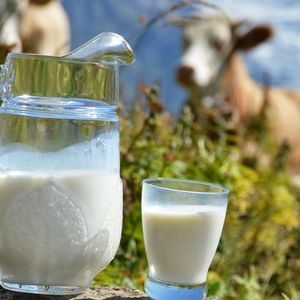In Praise of Raw Dairy
Science suggests that raw milk may be healthiest choice.
The Food and Drug Administration has warned us to steer clear for decades, but raw dairy devotees won't give it up. Despite being banned in some states, raw milk consumption is on the rise, and bills are consistently being introduced in state legislatures to loosen the restrictions on the sale of raw milk directly to consumers. Fans say it's richer in flavor, more nutritious than pasteurized milk, and that even lactose intolerant people can "tolerate" it.
Forbes called raw milk "one of the healthiest beverages on the planet" and noted that folks who consumed diets rich in unprocessed, whole foods have a very low risk of developing heart disease, diabetes, obesity, neurodegenerative disorders, osteoporosis, and cancer.
But if raw milk is such a super food, why is the majority of the milk we drink pasteurized?
Heat pasteurization was born of necessity in the 1920s. As the demand for milk increased and feed operations grew, unhealthy cows from overcrowded production operations started producing unhealthy milk. Cows contracted viruses and bad bacteria from unsanitary living conditions and an unnatural diet of grains and soy-based feed. Sick cows' milk makes people sick.
During the process of pasteurization, raw milk is heated to extremely high temperatures to kill off bad bacteria, making it safe for consumers to drink. Pasteurization also increases the shelf-life of milk; it's easier to mass market and maximize profits.
Raw milk advocates say that the nutritional benefits of milk are killed off during heat pasteurization. They also claim that pasteurization laws are set up to protect large, industrialized dairy operations. Small, organic dairy farmers are able to make a good income when they can sell raw milk directly to consumers. It's still illegal to sell raw milk in some states, though, and it's against federal law to sell across state lines. Despite the laws, raw milk has always been in demand. A milk trafficking gang known as the "Rawesome Three" even sprang up in 2012.
The Nutritional Benefits of Raw Dairy
The FDA's warning about raw milk isn't exactly wrong - it's just not complete. Not all raw dairy is the same. Raw milk won't make you sick if it's produced sanitarily from cows that are fed organic, natural diets of good, clean grass. Unlike pasteurized milk, raw milk is a living food, rich in good gut bacteria, natural enzymes, and fat soluble vitamins.
In fact, raw, organic milk from grass-fed cows is actually healthier. Pasteurization reduces vitamins, kills good gut bacteria, and destroys natural enzymes in the milk. It's also known to cause tooth decay, allergies, colic in infants, and even growth problems in children. When pasteurized milk is fed to calves, many die before maturing.
The benefits of raw dairy, on the other hand, include boosting the immune system, easing allergies, reducing the symptoms of asthma, healing gut issues, and even preventing cancer. Raw milk has more butterfat than pasteurized milk, which is rich in fatty acids like conjugated linoleic acid (CLA), known to fight cancer (specifically breast, intestinal, and bone cancers). It's also rich in vitamins, minerals, and good bacteria like lactobacillus acidophilus.
According to a study by the Journal of Allergy and Clinical Immunology, raw milk is one of the healthiest foods for growing children. It strengthens their immune system for life and reduces their chances of developing asthma and allergies. Raw milk also comes with the lactase enzymes needed to properly digest lactase. Problems with digesting lactose arise when people drink pasteurized milk that no longer have living lactase enzymes. Lactose intolerant people can actually tolerate raw milk.
If the nutritional benefits of raw dairy aren't enough to convince you, Dan Barber, chef and owner of the Michelin star restaurant Blue Hill, says the taste is superior. Raw milk has a richer taste because it isn't homogenized. Without homogenization, the cream is left intact.
While he can't serve raw dairy in his restaurant (due to legal restrictions), he does rely on it at home. "I'm an advocate for flavor. I think milk has a superior flavor when it's not pasteurized. [My personal opinion] is that nutrient-density benefits follow flavor," he told the New Yorker.
How to Find Raw Milk
Raw milk supports your local economy and organic dairy farmers. It also promotes healthy, environmentally-friendly farming practices. You can't find raw milk for sale in your local grocery store, though. You can search for raw milk available for sale near you on RealMilk.com or The Weston A. Price Foundation.
In states where the sale of raw milk is still illegal, people have managed to bypass laws by sharing "ownership" of grass fed cows or goats at local organic farms. By claiming animals as "pets" (even when they live off your property), the milk is yours, not technically for sale, and legal to drink.
In states where the sale of raw milk directly to consumers is legal, you can buy raw milk from a local organic farm. You can even get raw milk delivered to you in most major cities. If you live in New York City (or the surrounding metro-area), Dutch Meadows Farm and Triple Organics Farm deliver a variety of grass fed meats and raw dairy products to pick-up locations. A gallon of raw milk will cost you about $7.50.
